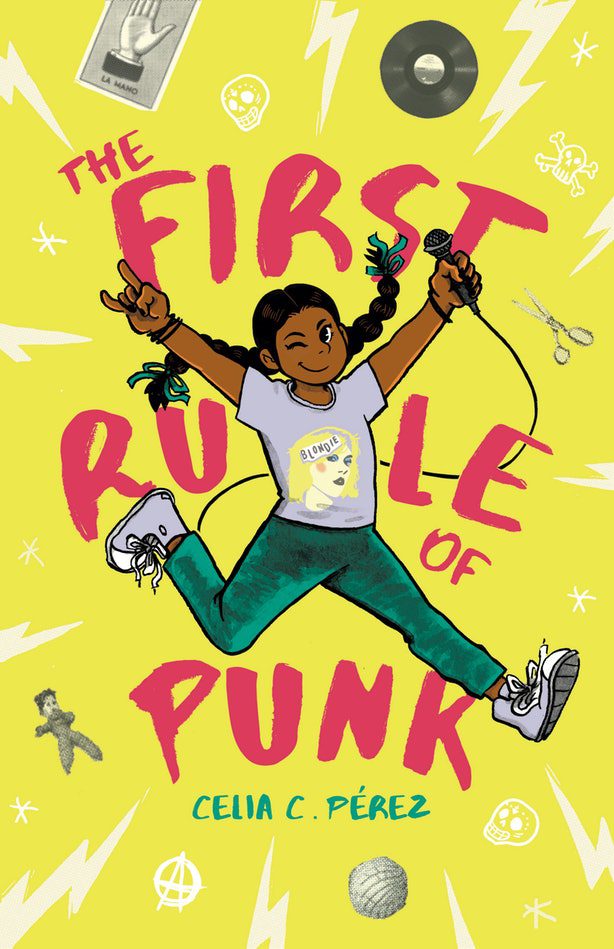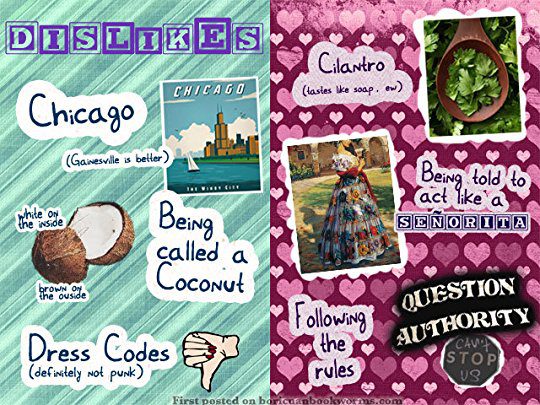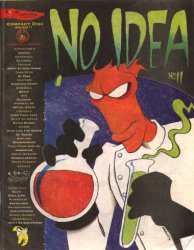
Marianne Joan Elliott-Said aka Poly-Styrene of X-Ray Spex, once sang: “When you look in the mirror / Do you see yourself / Do you see yourself / On the TV screen / Do you see yourself / In the magazine?” Culture, the construction of identity, and the role that elders play in guiding us toward our sense of self are among the central issues Celia C. Pérez addresses in The First Rule of Punk.
When the story begins, twelve-year-old María Luisa O’Neill-Morales’s parents are amicably divorced. Malú is into punk music, skateboarding, and zines. She isn’t too excited about moving to Chicago for her mother’s teaching appointment, and her first days at her new Latino-majority school are filled with stumbles and missteps. Her Mexican-American mom wants her to be a proper señorita. Her white dad says things will get better as long as she remembers the first rule of punk: be yourself. Over the course of the book Malú begins to synthesize these seemingly disparate influences and discover authentic self-expression.
Pérez, herself a long-time zinester, is a second-generation Cuban-Mexican-American who grew up in Miami and currently works as a community college librarian in Chicago. The First Rule of Punk is her debut book.
***
The Rumpus: What were some of your inspirations for writing The First Rule of Punk?
Celia C. Pérez: My parents were born in Cuba and Mexico, I was born in the US, and my son is another generation removed from those cultural ties. His experience as a Latino is different from mine, and when he grows up, his kids’ will be different too.
When he was born, I started reading a lot of children’s books. There are a lot of really beautiful books, but often they fall into limited categories—concept or holiday books for younger kids and issue books for older kids. Those things are important and necessary, but I wanted to see something more. We need a variety of representations of Latino identity and experience.
Rumpus: When did you first develop the ideas for this story?
Pérez: I started writing an earlier version around 2012 with a younger character, and this published version evolved a couple of years later. I knew I wanted it to be about a character who had very different parts of herself that she wasn’t quite sure how to make fit together—or if they even could fit together. Initially she rejects one part of herself, but then goes through a journey where she figures it out with the help of this community she forms.
Rumpus: Was it directly based on your own experiences growing up?
Pérez: As the bicultural child of immigrants, I bring that perspective into the story, but it’s not autobiographical. I knew that I wanted Malú to be Latina, but maybe a little different from what you often see in children’s books.
Rumpus: Something that strikes me immediately about this book is the balance between universal or common experiences, e.g., the awkwardness of middle school, divorced parents, moving and starting a new school, and Malú’s very specific experiences as a bi-racial, bi-cultural kid. And of course, there’s punk—not just as a musical genre, but also as a kind of ethos.
Pérez: I sometimes think about how people interpret the title of the book and wonder if they would reject it because they aren’t into punk music. But I think punk is more than music or an aesthetic. It’s about making your own thing, either because it doesn’t already exist in the world or exists but not in the way that fits you.
Rumpus: Tell me more about how that plays out in the story.
Pérez: For Malú, she’s never really questioned her Latina identity, but at the same time it was always something her mom was trying to push on her. Her mom is really immersed in the culture and history, maybe in a way because she’s trying to compensate for something that she feels is missing or that she’s not enough of. And then Malú comes to this new city where she’s suddenly surrounded by Mexican-Americans and goes to a school that is predominantly Mexican-American, and for the first time she sees there are all these different ways of expressing that identity.
Rumpus: Yes, she learns a lot from her new peer group.
Pérez: The antagonist Selena is a mini “Super-Mexican” (which is what Malú calls her mom), her new friend Joe is a little more on the outside of the mainstream popular kids, and Benny is a musician with strong ties to traditional music. It was important to put her in an environment where she could see how different people identify as Latino in order to find her own way.
Rumpus: But she struggles a lot along the way. At first she gets teased for not being Mexican enough. She doesn’t speak much Spanish, or like cilantro, and she prefers Soyrizo to chorizo. Her new school is also where she hears the word “coconut” for the first time—referring to kids who are brown on the outside, but white on the inside…
Pérez: Yes, but she takes that punk idea of embracing what it means to be different, or weird, and putting another spin on the term “coconut” that gives her some ownership over it instead of it just being a label she’s given.
Rumpus: She actually flips this into the name of a punk band she forms with her new friends, which she calls “The Co-Co’s.” But when The Co-Co’s plan to play at the school’s upcoming anniversary fiesta and talent show, the Principal rejects them because they don’t conform to her ideas about tradition. The Co-Co’s decide to put on their own DIY talent show, which they call Alterna-Fiesta.
Pérez: Erika Sánchez, who wrote I Am Not Your Perfect Mexican Daughter, has addressed this, too—this idea of finding your own way, pushing against expectations and pressures. At times Malú is not likable, but who is likable all the time? From Claudia in From the Mixed-Up Files of Mrs. Basil E. Frankweiler to Harriet from Harriet the Spy, not every character has to be a goody two-shoes. A goody two-shoes wouldn’t have the spunk to stand up to the principal, or the courage to embrace her own identity.
Rumpus: Malú also gets encouragement from Joe’s mom, Mrs. Hidalgo. Tell me more about the role of this character in the story.
Pérez: Mrs. Hidalgo owns a neighborhood coffee shop: She’s not just into punk, but she is also really into her Mexican heritage. When she starts talking with Malú about music it’s the first time it really clicks for her that she can bring these things together. Growing up, I had adults I looked up to, but I never quite felt like I fit in, and I never saw an adult that gave me a sense of how I might bring these things together that didn’t seem to fit for me. The character of Mrs. Hidalgo provides that balance, that something I was always looking for as a kid—and still look for as an adult.
Rumpus: Mrs. Hidalgo is able to give Malú something neither parent can. Aside from being into punk and her Mexican heritage, is it also because she’s a non-related adult, therefore outside of the family dynamic?
Pérez: You know Malú’s dad plays a less central role in the story, and I remember reading one review where he was described as a slacker…
Rumpus: Well he can’t be much of a slacker if his indie record store is still going…
Pérez: [Laughs] His apartment is above the record store so when she goes there she’s totally immersed in his world. In the beginning of the book she spends time with him before she moves, and it kind of fuels that dynamic she has with her mom. Maybe because Malú lives with her, and she’s setting the rules, her dad has more of an appeal. She sees punk as being about not doing what’s expected of you.
Rumpus: Yes, but his version of punk is stuff like The Ramones and Blondie. There’s a key scene where Mrs. Hidalgo plays the album Attitudes by The Brat for Malú. When she introduces Malú to Teresa Covarrubias, the band’s Chicana singer, she helps her to affirm and reclaim an important part of her cultural lineage. Where did you first encounter punk, and specifically Latino bands like The Brat?
https://www.youtube.com/watch?v=qVqXwlmrffA&w=550
Pérez: Definitely later than Malú. The neighborhood where I grew up was and still is predominantly immigrants—and the kids weren’t into punk. When I left home for college, the town in North Florida where I moved was predominantly white, and being in this unfamiliar environment forced me to question for the first time what role my history and heritage played in my identity. I discovered punk around the same time as I started this exploration.
Rumpus: Latino punk?
Pérez: When I started getting into punk music, I also started looking around for other brown people in punk. Years later I remember seeing Mas Alla de Los Gritos, the documentary about Latinos in punk by Martin Sorrondeguy, who was the vocalist for Los Crudos. Any time I would discover Latino punk bands like The Brat or The Plugz it was just mind blowing and exciting. I wasn’t in a band, but I went to shows and made zines, and just to know people like Alice Bag were out there was affirming.
Rumpus: Let’s talk about zines a bit more. Malú is really into them, and throughout the book she uses zines, which are embedded in the story, as ways to explore her identity.
Pérez: Like a lot of kids in my generation, I think I first encountered zines in Sassy magazine! [Laughs] You know they had that “zine of the month” column and every once in a while I’d order something they featured. But I think the first zine I encountered on my own was associated with an independent record label in my college town called No Idea. Soon after that I found a personal zine by someone who was also local and played in bands. I was like, “Wow! You can do this? You can write about yourself, and your world, and experiences, and copy it, and staple it, and give it away? That’s pretty cool!”
Rumpus: Several colleges now have zine collections as does the New York Public Library and the DC Public Library, where the librarians even have their own zine about making zines called “Maximum Preservation.” Do the zine and library worlds cross over for you as well?
Pérez: There are a lot of punks and zine-makers who have gone into librarianship, and a lot of people have found ways to bring those two things together. I work as a librarian in the community college system, and I’ve kept the two things pretty separate mostly because I do a lot of personal zines which I didn’t want seeping into my work world.
Rumpus: But is the conceptual relationship still there? When you’re making a zine, or a mixtape, or a book, you’re making something that’s intentionally not generic, and the people who encounter it may connect with it through various entry points. And at the end of the book, you’ve included instructions on how to make a zine, so the reader is invited to tell her own story.
Pérez: Yeah, what I love most about punk is the idea of being yourself and creating in the world what you don’t see. It’s liberating and empowering. Kids need that encouragement.
***
BONUS MATERIAL
Here’s Celia’s playlist of great songs that inform and inspire Malú’s journey:
***
Author photograph and images from the book provided courtesy of Celia C. Pérez.
***
This interview has been edited and condensed. If you’d like to recommend someone for “Sound & Vision,” drop Allyson a line here.








